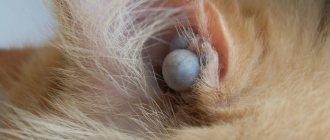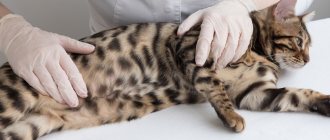Neoplasms on the body of cats require attention, as they can threaten the pet’s life. A hard lump on a cat’s neck may turn out to be an ordinary wen, which does not pose a danger if removed in a timely manner, but may also indicate the occurrence of malignant processes.
It is impossible to independently diagnose the nature of the neoplasm without a biopsy, so the first thing a loving owner should do when discovering a growth is to show the pet to a specialist.
Risk factors
In the vast majority of cases, owners of older animals encounter neoplasms on the withers and neck of cats. The appearance of soft cones and balls is due to the natural aging of the animal’s body. Risk factors for this:
- The pet is over 8 years old;
- Endocrine disorders;
- Obesity;
- Presence of parasites.
Only a veterinarian can accurately identify the nature of the lump, the cause of its appearance and suggest treatment methods. Self-medication in the presence of formations in pets is not allowed.
Treatment
Depending on the type of cone, the treatment is different:
- The wen opens on its own when it is “ripe”. A viscous substance is released from the hole after opening. You need to carefully squeeze out the contents and treat the wound with an antiseptic.
- The abscess is opened surgically and preferably under sterile conditions. If the inflammation is not opened, the abscess can burst and lead to infection of the entire animal’s body.
- In case of purulent lymphadenitis, the lump must be opened surgically and the wound must be sanitized. In the absence of pus, vitamin therapy is carried out, and physiotherapeutic procedures are prescribed. It is imperative to establish the cause of inflammation of the lymph nodes and first of all fight the cause of the underlying disease (for example, sore throat).
- Benign tumors and cysts are removed surgically if they cause discomfort and worsen the animal’s life. If the cyst is small or if the animal's condition does not allow surgery, the growth and development of the cysts is monitored.
- The tumor goes away on its own after vaccination; no special methods or treatments are required.
- Oncological tumors are treated only by surgery. Moreover, during the operation, not only the tumor, but also part of the healthy tissue is cut out in order to avoid further development of the tumor. Chemotherapy courses are being carried out.
Abscess on the neck
A lump on your cat's neck may be an abscess. This is a cavity filled with pus. It appears at the sites of wounds and injuries, and may be a consequence of skin irritation by parasites, in response to which the pet scratched the wound.
Abscess symptoms:
- Homogeneous structure of the neoplasm.
- Redness and increased temperature of the skin around the affected area.
- Pain when pressing.
With an abscess, the cat is constantly trying to reach the tumor. If she can't scratch her neck with her paw, she starts rubbing herself against the furniture. Thus, the animal tries to get rid of the annoying lump on its own.
Since an abscess is a purulent inflammation, a general deterioration in the pet’s well-being is possible. The cat may become lethargic or, on the contrary, irritated and refuse to be handled.
Only a veterinarian can quickly relieve an animal of discomfort. The abscess is opened with a scalpel, then the cavity filled with pus is cleaned out and the wound is treated with antiseptic. If necessary, the doctor may apply stitches and prescribe antibiotics to prevent the inflammation from reoccurring.
We recommend the article: Why does a cat not open one eye?
An abscess can open on its own, but this is dangerous for the animal’s health. The cat can lick off the purulent contents, but there remains a risk of re-infection of the resulting wound.
Associated symptoms
Apart from the presence of a lump under the skin, the animal may not show any other symptoms. Wen and benign neoplasms, as a rule, do not manifest themselves in any way.
In some cases, the tumor constantly increases in size, as a result a large lump grows and begins to interfere with the cat and cause inconvenience. In such cases, measures should be taken as soon as possible.
Firstly, the rapid growth of a tumor is a dangerous sign. And secondly, the cat will try to get rid of the irritating factor by scratching or trying to rip off the bump in some way. This can lead to aggravation of the pathological process, injury, and bleeding from the damaged area.
In some cases, when a cat develops a gradually enlarging lump under the skin, a number of additional symptoms are observed. Suppuration or an inflammatory process may be accompanied by hyperemia of the affected area, skin tension, swelling and severe pain. Also, due to the activity of pathogenic microflora, symptoms of intoxication increase: fever, weakness, and sometimes nausea and vomiting.
Allergic reactions can be accompanied by extremely unpleasant itching sensations for the cat. Itchy skin provokes scratching, damage to the skin and aggravation of the problem.
Lump on a cat's neck photo
Diagnostics
Lump on the cat's stomach under the skin, tumor
To identify the cause of the seal, it is recommended to contact your veterinarian, who will prescribe the following diagnostic tests:
- general clinical analysis of urine and blood, blood biochemistry;
- puncture of fluid from the cone;
- Ultrasound of the abdomen on the left or right side, where the tumor is located;
- palpation on the right and left of the neck to determine the symmetry of the tissues and the presence of compactions;
- X-ray of the neck.
For your information! When a puncture is performed, the liquid is sent for laboratory analysis. Can detect bacteria, viruses, fungi, and various toxins. For this purpose, PCR, ELISA, bacteriological culture, and microscopy are used.
Sometimes the doctor only needs one palpation to make an accurate diagnosis.
An ultrasound scan reveals the presence of liquid or solid contents of the lump. X-rays can show tissue damage and the presence of a tumor. Using palpation, the doctor determines the density of the formation. It can be connected to the capsule or be separate from it, moving like a ball.
Malignant neoplasms
A soft lump on a pet's neck can pose a threat to the cat's life. In older animals, the appearance of a neoplasm may indicate oncology.
Malignant lumps do not have specific symptoms; only a specialist can make a diagnosis. As a rule, with cancer, a cat feels unwell and lacks strength, refuses to eat, and begins to lose weight. Since these symptoms are common to other diseases, you should immediately show the animal to a specialist.
To make a diagnosis, the doctor will do an X-ray or MRI. If a malignant tumor is suspected, a biopsy is performed - removal of particles of the tumor for the purpose of histological examination of tissue cells. Based on the results of histology, a decision is made on further treatment. The lump must be completely removed, and the animal is prescribed a course of chemotherapy.
Hormonal disorders and breast cancer
The second reason for the formation of lumps in a dog may be the development of a mammary tumor. Unlike mastopathy, tumors usually have focal localization. There are several causes of breast tumors. But the main predictive factors are the following: - constantly recurring estrus - long-term absence of mating during the reproductive period - hereditary factor - long-term use of hormonal drugs
Tumors on the mammary glands can be either benign or malignant. But the percentage of benign formations is very small. Thus, 9 out of 10 neoplasms on the mammary glands in cats are cancer. Tumors can be easily detected by simply palpating the surface of the mammary glands. You may notice the appearance of lumps and nodules in your dog, which may increase in size if no measures are taken. As a result, the tumor can grow and develop into a malignant pathological form.
At first, the tumor is usually quite small in size and rarely grows, but the tumor can abruptly move into the first stage of the disease after false pregnancy. The number and size of the bumps may increase, and the surface becomes bumpy.
If you trust statistics, then a common cause of death for most animals in the second half of life is oncology in cats and dogs . It firmly holds second place among the causes of overall mortality. However, as in humans, if a tumor and lump in a cat are detected in a timely manner, then surgical treatment in the early stages usually leads to a complete recovery. If you do not seek help from a veterinarian in time, the tumor will grow and cause complications. Enlarged lymph nodes may be noted. At the last stage, the tumor metastasizes to other organs. At this stage of the disease, the prognosis is unfavorable with any type of treatment. Frequently asked veterinarian questions
If a cat has a small and single lump near the nipple, should it be taken to the vet? Naturally. Even the smallest neoplasm can become the beginning of a malignant tumor. It is easiest to take action at the onset of the disease.
If the mammary gland is swollen over the entire surface, but the cat feels well and eats, then should you worry? Swelling may be a sign of an unfavorable process. To find out exactly the nature of the process, you need to contact a veterinary clinic.
The cat has lumps all over the mammary gland. The doctor suggested removing the entire gland. Is this dangerous for the dog? There are no simple operations. Especially oncological ones. The intervention proposed to you should be carried out by a veterinarian with experience in such interventions. After surgery, a histological examination is required. And, if necessary, adjuvant chemotherapy.
Incipient breast tumor.
Developed breast tumor.
As soon as a lump has been detected in a cat or dog, or if there are indirect signs that allow one to suspect cancer, we recommend that you consult a veterinarian without the slightest delay.
Unfortunately, this problem cannot be solved at home. We have all the necessary conditions for the examination and treatment of cancer in dogs and cats.
Breast tumor. Despite its small size, this is already a neglected case. Metastases.
Lipomas in cats
If a cat has a soft lump on its neck that easily rolls under your fingers and does not cause discomfort to the pet, a lipoma or wen is a possible cause.
The reason for the appearance of such seals is the peculiarity of the functioning of the animal’s sebaceous glands. The formation of lipomas is often associated with endocrine disorders and obesity in older animals.
Wen themselves are not dangerous, but must be removed, especially if they are located on the pet’s neck or head. The fact is that a benign lipoma can begin to degenerate into cancer with age, so veterinarians recommend removing lipomas in a timely manner.
Causes of appearance and main types of neoplasms
There are 2 types of lumps or bumps on the body:
- Benign. They pose a danger only when they reach large sizes. In this case, adjacent tissues are infringed and nutrition and blood supply are disrupted. Metastases of the lump of benign etiology do not occur.
- Malignant. Tumors consisting of degenerated pathological cells prone to metastasis. If a cat’s lump is cancerous or large, there is very little chance for the pet to recover and recover.
Most often, the formation is benign in nature; the following types are distinguished:
Most often, this formation refers to a lipoma.
- Hematoma. If a cat has a blue-violet hue on its head, hips, under the eye or on its back that causes pain when pressed, most likely it is a hematoma or bruise. The formation is caused by an injury in which small vessels are damaged; sometimes such a lump can fester and develop into a cyst.
- Lipoma. The subcutaneous wen in a cat is formed from adipose tissue, when pressed it does not cause discomfort, sometimes it rolls around inside. If a small lipoma grows, it is better to remove it.
- Cavernous hemangioma. Red bumps on the stomach, side and even on the butt, which do not cause discomfort to the animal, represent vascular growth of benign etiology.
- Syringoepithelioma. It is a modified element of the sweat gland. Often such a lump appears on a cat’s stomach. The seal does not cause discomfort and does not grow.
Other types of cones, less common
The following neoplasms are often found in cats:
Older animals are more susceptible to melanoma.
- Abscess. Occurs on the thigh, elbow or face due to a bacterial infection on damaged skin. The lump may be blue and fester, causing the cat pain, fever, and fever.
- Cyst. Often formed as a result of blockage of the sebaceous glands, they can appear on any part of the body - on the forehead, near the neck, at the base of the tail, on the paw. The growth is not prone to malignant degeneration and is painless.
- Melanoma. Growths in the form of moles. Often they are black, dark blue, brown. Mostly appear in old animals.
- Mammary cancer. First, a compaction forms in the area of the gland of the same name. But then the tumors spread to the entire body. The lump can be black, purple, and often bleeds.
Sometimes a ball-like tumor on the neck, under the jaw, in the ear, on the outer side of the thigh, under the armpit or in the spine area is a tick that has embedded itself and grown to a large size. In such a situation, the parasite must be urgently removed, but it is important to do this correctly so that the insect elements remaining under the skin do not lead to suppuration and the formation of an abscess. A lump on the pad of a front or hind leg may be a manifestation of a common paw disease called coronitis.
What to do if the terrible diagnosis of a tumor in cats is confirmed
Of course, there is no need to panic in the first place. Animals perfectly sense the mood of the owner who is nearby. Remain calm, which will certainly rub off on your pet. You also need to undergo a large number of tests and prepare yourself for a long fight against the disease. Veterinary doctors will do everything possible, and will also show the owner all the possibilities of modern medicine, which is capable of real miracles. It is quite possible that our drugs and skilled doctors will help cure such a terrible disease as a tumor. We are responsible for those we have tamed, and therefore it is not recommended to abandon a pet with a tumor to the mercy of fate. Having suspected something was wrong, it is also important to warn household members that they should be as attentive as possible to the animal and, if possible, not feed it harmful sausage or sausages, even if you want to support your cat and treat him with his favorite treat.
Treatment options depending on the cause
Your dog has a lump under the skin on his back or side
To treat a cat and prevent relapse of the disease, the cause is first identified. Only after this are various methods of therapy prescribed. This is the most effective method.
Treatment of a benign tumor
Benign tumors are eliminated using surgery. The tissue is incised, the tumor and capsule are removed, and sutured. If the lump is small, it can be left in the animal’s body, periodically checking for the possibility of its growth.
Lipoma treatment
Lipoma is treated in the same way as a benign tumor. The doctor may remove it if it is interfering with the cat's activities. For example, the presence of a lipoma in the front makes the swallowing reflex and breathing difficult. If it is minor, it is left without damaging the tissue.
The cat moves away quickly after the lump is removed
Abscess treatment
Most often, the abscess is eliminated. To do this, the method of suction using a syringe is used. To eliminate the negative impact on the cat, he is given local anesthesia or general anesthesia.
Important! If the resulting fluid is yellowish or purulent, antibiotics are prescribed, as this is a sign of bacterial inflammation.
Treatment of lymphadenitis
To eliminate lymphadenitis, it is necessary to eliminate the infectious or viral load on the animal’s body. Stimulate his immune system so that it can better cope with infection. Vaccination can be used for this. A small amount of pathogenic microorganisms is injected subcutaneously, which reacts with the immune system.
Treatment of ticks
To prevent ticks, drops, tablets, and injections are used, which destroy the attached tick before it injects poison. If the animal does become infected, medications are used that completely neutralize the toxins. These medications are very harmful to the liver. After this, the animal should be fed food that reduces the load on the liver.
Treatment of scratches
If a scratch appears on the animal’s body, it should be treated with an antiseptic. This could be miramistin, chlorhexidine, hydrogen peroxide, baneocin. This will prevent infection from invading.
Treatment of insect bites
If the insect has low toxicity, the animal’s body will cope on its own. But an antihistamine should be given to reduce swelling and inflammation.
Treatment of mastitis
If purulent mastitis appears, broad-spectrum antibiotics are immediately given. If the lump does not resolve on its own, your veterinarian may remove it during surgery.
Treatment of hematoma
If the animal has a hematoma, it is sucked out using a syringe. But if the hematoma is minor, they give the animal the opportunity to recover on its own.
A lump on an animal's body can mean a temporary phenomenon or a serious illness. It can appear in any area of the neck, occupying the right or left side, back or front. This is important for the doctor, since the seal can impair blood circulation and put pressure on the nerves, esophagus, and respiratory tract. In any case, it can be cured if you consult a specialist in time.
Lump as a reaction to the vaccine
If, after vaccination, swelling appears on the animal’s withers, most likely this is a natural reaction to the vaccine and there is no point in worrying. In this case, there is slight swelling and redness at the injection site. The main causes of post-injection bumps are:
- individual intolerance to the components of the drug;
- age (over 7 years) or overweight cat;
- belonging to a certain breed (hairless purebred cats tolerate vaccination more difficult);
- incorrect administration of the vaccine;
- using an unsterile needle;
- poor choice of injection site.
In most cases, this reaction does not cause concern to the animal and goes away after some time. Treatment is usually not required, but an alcohol compress can be used to speed up the distribution of the vaccine.
Possible consequences.
Complications after vaccination are quite rare, but nevertheless occur in a number of cases.
It is necessary to contact a veterinarian if:
- the lump turned very red and began to grow;
- the animal’s temperature rises above +39⁰C for several days;
- after a month, the swelling did not disappear or became denser;
- pressing on the lump causes pain for the pet;
- baldness of the skin around the vaccination site was detected.
Complications after vaccination can manifest themselves in the form of an abscess (a cavity filled with purulent fluid) and sarcoma (a malignant tumor).
A tumor on a cat's stomach can be of different types.
It’s worth starting with the fact that all these unpleasant things are produced at the expense of the resources of the cat’s body and, according to the degree of aggressive impact on it, they differ into benign ones and those that pose a direct threat to life. Of course, a veterinarian should know all these types well in order to provide quality care, however, this information will also not hurt the ordinary owner and will be an excellent help in treating a terrible disease. Neoplasms that do not cause harm (benign) grow slowly, putting pressure on and expanding the tissues that surround them. These tumors do not grow and do not recur after removal.
A benign neoplasm does not deplete energy for the life of the body, but probably has a mechanical effect on it . For example, when a tumor begins to compress blood vessels, it can go, for example, to the heart or liver.
Malignant tumors, as a result of overly active division of cellular elements, grow rapidly. They are characterized by uncontrolled development. In other words, the tissue that surrounds the vessels is gradually destroyed. However, these tumors may remain small. They rarely grow to a large size, since the animal is quickly sent to the next world due to exhaustion and intoxication . In addition, malignant tumors are characterized by:
- Metastasis is a unique skill of cells. They spread throughout the body with blood, lymph and contact give rise to other similar tumors. Also, despite all the persistent treatment, a relapse of the disease is possible.
- Relapse is the re-formation of metastases, the re-growth of the tumor. Cats can develop both “good” and “bad” tumors.
The peak age for such diseases is 10-12 years. This is only according to official statistics. Swelling of the skin and subcutaneous tissue occurs quite often in cats. It has not yet been determined which cat breeds are most susceptible to tumors. The chest and area around the nipples are a favorite place for tumors to appear.











